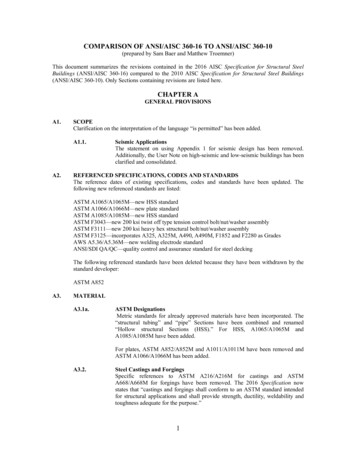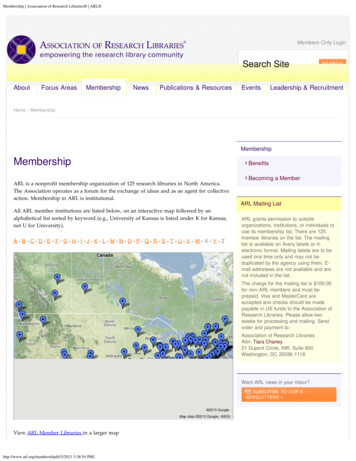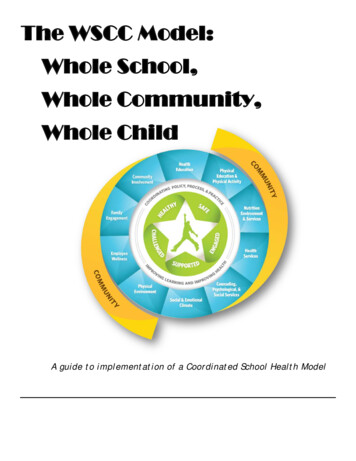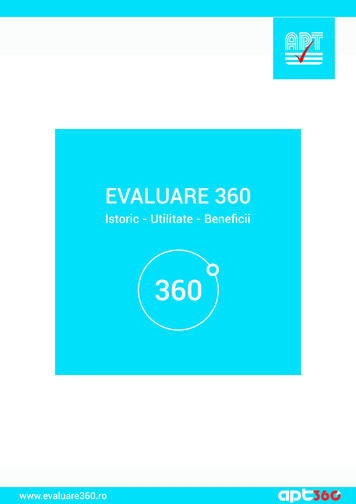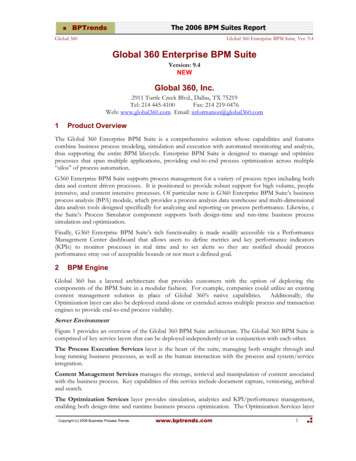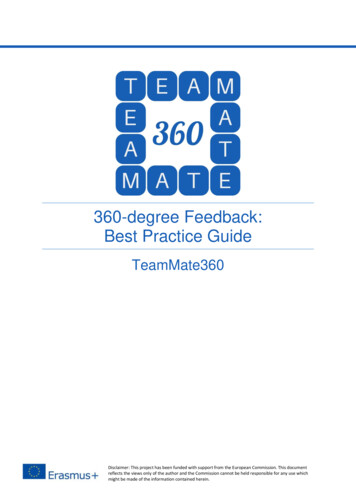
Transcription
28th Annual ASDAL ConferenceLibraries 360 : The Whole PictureJune 22 - June 28, 2008Loma Linda University, Loma Linda, California
ASDAL OFFICERS, 2007-2008President: Sabrina Riley, UCPresident-Elect: Carlene Drake, LLUPast President: Ruth Swan, FAMUSecretary: Lauren Matacio, AUTreasurer: Lee Marie Wisel, CUCASDAL Action Editor: Sallie Alger, AUFor membership and other information, write:ASDALColumbia Union College Library7600 Flower Ave.Takoma Park, MD 20912Editor: Sallie AlgerASDAL Action is the official publication of the Association of Seventh-day AdventistLibrarians. Its purpose is to keep members abreast of the association’s activities, collectiondevelopment projects and activities related to SDA materials, and the progress of SDA librariesthroughout the world. It includes book reviews, bibliographies, and articles that keep SDAlibrarians up-to-date with the profession.It is published three times a year: fall, winter, and spring. Deadlines are October 15, January 15,and April 15. Your subscription is part of the ASDAL membership fee. Non-members pay 20.00 per year.Forward manuscripts for publication, using Word, Times New Roman, 10 pt., to:Sallie Alger at salger@andrews.eduASDAL WEB SITE: http://www.asdal.org/
Volume 27, Number 3Spring 2008ISSN 1523-8997ASDAL 2008—LOMA LINDASCHOOL LIBRARIAN PRECONFERENCEBy Carlene DrakeBy Katye HuntWe have planned an exciting conference in Juneon the campus of Loma Linda University. If youhaven’t already registered, please do so now.The registration form is on the ASDAL website.The conference will be held in the RandallAmphitheatre adjacent to the Del E. Webblibrary. We begin on Sunday with twopreconference programs; Adventist ResourcesSection and School Library Section. This isfollowed by three full days of programs,Monday, Tuesday, and Thursday; and one day,Wednesday, touring the Huntington Library andthe Getty Museum. The final event will be thebanquet on Thursday evening in the WongKerlee Conference Center. Sabbath afternoonthe 21st, a potluck lunch will be provided at theLibrary on the La Sierra University Campus witha tour of the campus in the afternoon.Transportation will be provided to La SierraUniversity for those who need it. Please send usan e-mail at asdal2008@llu.edu if you plan toarrive on Friday and would like to join us at LaSierra on Sabbath afternoon.8:00 Registration8:30 – 9:00 Devotional TBA9:00 – 9:50 The School Library: A Window toFaith and Academic OpportunityAnnette Melgosa, Instruction/Access Servicesand Periodicals Librarian, Walla WallaUniversityAbstract: Seventh-day Adventist Schools offerwindows through which students can see thelight of faith and visions of academicopportunity. One of these windows is the schoollibrary. From a faith perspective, the library isuniquely situated in the school to offer manywindows into faith issues. And in terms ofacademic opportunity, studies show that a goodschool library positively affects studentachievement. Students achieve better if theirschool libraries are run by dedicated and trainedstaff, have up-to-date collections, and areengaged in teaching information literacy skills.Loma Linda University has two churches oncampus. Pastor Randy Roberts will be thefeatured speaker on Sabbath before and after theconference at the University Church. HyvethWilliams is the pastor at the Campus Hill church.At this writing the Campus Hill web site did nothave the June schedule posted. In addition to agreat conference, Southern California offersmany fun and exciting side trip options.Disneyland is about an hour drive from LomaLinda in Anaheim. San Diego has a world classzoo, and the San Diego Wild Animal Park. Planto join us for a great conference and fun summervacation. Check the ASDAL Website for10:00 – 10:15 Break10:15 – 10:45 Need Help? Turn to LibraryPagesAudrey Campbell, Media Center Director,Rogers Adventist SchoolAbstract: A short presentation and discussion onhow Rogers Adventist School uses studenthelpers in an elementary school media center.more complete information coming soon!Carlene Drake, ASDAL President-Elect,Director, Loma Linda Libraries, Loma Linda,California (cdrake@llu.edu)Volume 27 Number 31Spring 2008
10:45 – 11:30 Standards for the 21st CenturyLearnerPaulette McLean Johnson, Library Director,Oakwood UniversitySo how do school teacher-librarians lead theirstudents to locate quality print and electronicreference sources? Robert DuBose will presentsome of his strategies and encourage the group toshare information on this vital informationliteracy issue.Abstract: The American Association of SchoolLibrarians' new standards provide a frameworkfor school library programs and a tool forinstruction. This presentation will engageparticipants in a review of the standards; exploreintegration in curriculum and offer strategies forteaching skills and dispositions.3:15 – 3:30 Break3:30 – 4:30 Getting Those Feet InBruce McClay, Librarian, Walla WallaUniversity School of Nursing, Portland, Oregon.11:30 – 12:00 Hands-on MendingAbstract: Writing in 1909, Sam Foss in ―SomeCardinal Principles of a Librarian’s World‖ said,―A dollar bill that never circulates is not worth asmuch a cent that keeps moving. Nearly everylibrarian ought to double the circulation of hisbooks ‖ A lofty goal, but how do you get yourfaculty and students to use and value theresources and services that you offer? First, wewill look at some of the basic principles ofsuccessful marketing and some strategies thathave worked in school libraries. Second, we willbreak into small groups and you will be giventhe opportunity to discuss concerns, formulateplans for change, and share things that haveworked for you. Books that sit on the shelf anddatabases that are never used are not worthmuch. What have you done to get those feet inthe door? What are you doing to get yourstudents and faculty using the resources andservices that you offer? We will learn from eachother.Katye Hunt, ANGEL Director, Southern UnionConferenceAbstract: Participants will receive a BRO-DARTmending book along with Magic-Mend and getsome hands-on experience with simple mendingtips.12:00 – 1:30 Lunch1:30 – 2:20 The Role of Social Bookmarking inSchool LibrariesChristina Cicchetti, EducationServices/Reference Librarian, University ofCalifornia Riverside.Abstract: This hands-on session explores therole of web 2.0 social bookmarking technologiesin school libraries, with special attention given tode.licou.us and the lists feature of Worldcat. Bythe end of the session, you will have created anaccount for yourself on one or both sites andgenerated some short lists of resources that youcan share with students and teachers.4:30 – 5:00 Business meetingKatye Hunt, Director of ANGEL, SouthernUnion Conference, Ooltewah, Tennessee(khunt@angelprogram.net)2:20 – 3:15 Google MORE Robert DuBose, Teacher Librarian, La SierraHigh SchoolIN THIS ISSUE—Abstract: Most 21st century student library usersare very confident of their research and inquiryskills. Many of them are not even aware thatthey need to go beyond Wikipedia and simplenatural language Google searches. They need tobe coaxed into understanding the differencebetween ―looking it up‖ on the Internet andquality inquiry-based searching.Volume 27 Number 3ASDAL 2008. . . . . . . . . . . . . . . . . . . . .1School Librarian’s Pre-Conference. . . . 1Prelim. Agenda ARS . . . . . . . . . . . . . .3Prelim. Agenda Business Meeting. . . . .3Past Hilts Scholarship Recipient. . . . . . 4Special Topics in Waldensian History. .5Book Reviews. . . . . . . . . . . . . . . . . . . . 7From a Distance . . . . . . . . . . . . . . . . . . 8BYTES & BITS. . . . . . . . . . . . . . . . . .102Spring 2008
ADVENTIST RESOURCE’SSECTIONPRELIMINARY AGENDA—BUSINESS MEETINGASDAL, 2008By Jim FordBy Sabrina RileyThe Adventist Resources Section will meet onSunday, June 22, beginning with a devotional at8:30. We have a program which will incorporatethe overall ASDAL conference theme of the―Whole Picture.‖ We hope to provide topics ona range of issues faced by those interested in andcaring for Adventist resources.1.2.3.4.5.Here is a summary of the program:8:30 Devotional, by Julius Nam, Professor ofChurch History, LLU School of Religion9:00 A Plea for Each of Us to TakeResponsibility for Engaging in the Preservationand Use of Adventist Resources. Thispresentation and panel discussion will be led byCristina Thomsen, Library Director,Southwestern Adventist University10:45 Swimming in the Mainstream: AdventistDecorated Cloth Bindings of the Late 19th andEarly 20th Centuries. This presentation is byLori Curtis, Associate Chair, Department ofArchives and Special Collections, Loma LindaUniversity. This will look at the books comingfrom the denominational publishers in thecontext of the larger publishing world.1:30 Collaboration and Cooperation inCollecting Manuscript Collections. Thispresentation is by Jim Ford, Associate Director,Center for Adventist Research, AndrewsUniversity2:30 Review and Moving Forward inCollaboration and Coordination. Discussion ledby Jim Ford3:30 Business session4:30 Tour of the Department of Archives andSpecial Collections, Loma Linda University.Tour led by Lori CurtisJames Ford, Associate Director, Center forAdventist Research, James White Library,Andrews University, Berrien Springs, Michigan(fordjim@andrews.edu)6.7.8.9.10. Reports of Working Committeesa. Adventist Resources WorkingCommittee (and election of 2members)b. School Library Section11. Reports of Standing Committeesa. Academic Rank and Tenureb. Adventist Library InformationCouncil (ALICE)c. Conference PlanningCommitteed. Constitution and BylawsCommitteee. Scholarship and AwardsCommitteef. SDA Classification AdvisoryCommitteeg. Seventh-day AdventistPeriodical Index PublicationBoardh. Site Planning Committeei. Statistics Committee Volume 27 Number 3Establishment of QuorumCall to order by ASDAL PresidentNaming of Parliamentarian for theBusiness SessionsReport of the Nominating CommitteeAnnouncement of Election Resultsa. President ElectElection of the Nominating Committee(Committee of 5)Selection of the Resolutions CommitteeReports of Executive Officersa. Secretaryb. ASDAL Action Editorc. Treasurerd. Past Presidente. President Electf. PresidentReports of Coordinatorsa. Distance Ed Coordinatorb. Oversees Coordinatorc. Publicity Coordinatord. Website Coordinatore. SDA Librarian Discussion ListManager3Spring 2008
12. Breakout Session Reportsa. Archivesb. Directorsc. Public Servicesd. Technical Services13. Special Committee Reportsa. Professional Recruitment AdHoc Committeeb. Library Manual Ad HocCommittee14. Chapter Reportsa. Africanb. Europeanc. Inter- Americad. South American15. Unfinished Businessa. Audit Processb. Web site revisionc. Frequency of ChapterMeetings16. New Businessa. 2012 Conference invitationfrom AIIASb. Regional and Overseas LibraryCoordinatorsc. Conference RegistrationScholarship for DevelopingNation’s conference attendees17. Resolutions18. Installation of Officers19. Announcements and Closing Prayer20. Adjournment of the 28th AnnualBusiness MeetingSabrina Riley, ASDAL President, Director, EllaJohnson Crandall Memorial Library, UnionCollege, Lincoln, Nebraska(sariley@ucollege.edu)Her interest in librarianship started at the age of12 when her mother suggested it as a possiblecareer field because Sabrina enjoyed readingvery much. In academy and college, she chosestudent assistant jobs in the library and thoseexperiences confirmed that librarianship was thecareer for her. It was also through these studentpositions at Andrews University (AU) andNewbold College that she learned about ASDALand the D. Glenn Hilts Scholarship.After graduating from UM in the spring of 1998,Sabrina was hired as the first full-timeinstruction librarian at AU. She held this positionuntil 2003 when she was offered the directorshipat UC.Sabrina has been involved with ASDAL throughcommittee memberships, presentations, andarticles in ASDAL Action. Before she becamepresident elect in 2006-07 (which included thejob of chairing the conference program atHelderberg College) and president in 2007-08,she has had experiences in planning conferencesby participating in local arrangements for the2000 conference at Andrews University and the2004 conference at Union College.Besides ASDAL, Sabrina holds memberships inseveral other library associations, namely, theAmerican Library Association, Association ofCollege and Research Libraries, and NebraskaLibrary Association. Union College is aninstitutional member of the Sirsi Midwest UsersGroup (SMUG—the regional users group for UCLibrary’s integrated library system). She served atwo-year term as co-program chair and helpedplan SMUG’s annual meetings. She gave onepresentation at a SMUG annual meeting. The Scholarship has benefited Sabrina and hasbeen instrumental in the recruitment of Adventistlibrarianship. It is never too late to include the D.Glenn Hilts Scholarship in your will and/or tosend your donations but don’t wait too long.Now is the time to act! It may be too late for thisyear’s tax season but not for next year, so kindlysend your tax-deductible donation to: TheCommunity Foundation, 3880 Lemon Street,Suite 300, Riverside, CA 92501 and specify itfor the D. Glenn Hilts Scholarship.PAST HILTS SCHOLARSHIPRECIPIENT: Sabrina RileyBy Cynthia Mae HelmsThis second article featuring the D. Glenn Hiltsscholars will focus on ASDAL President SabrinaRiley who received the scholarship in 1996while attending the School of Information at theUniversity of Michigan (UM). She currentlyserves as the Library Director of the EllaJohnson Crandall Memorial Library at UnionCollege (UC), Nebraska.Volume 27 Number 34Spring 2008
Please send a copy of your letter to the CynthiaMae Helms, Chair, ASDAL Scholarship andAwards Committee, James White Library,Andrews University, Berrien Springs, MI 491041400.Cynthia Mae Helms, Chair, ASDAL Scholarshipand Awards Committee, Head, Dept. ofInformation Services, James White Library,Andrews University, Berrien Springs, Michigan(helmsc@andrews.edu)What a blessing to have Pastor Dwight Nelson,along with his wife Karen, join us on our journeythis year. Each morning we met on the verandaof our hotel where Karen Nelson led out inmusic and Pastor Dwight held our worships.On our first day we hiked the steep andsometimes treacherous trail to Castelluzzo. Atthe top there is a prominent stone abutment witha monument to commemorate the thousands ofWaldensians who were tossed to their death fortheir scripture-based faith. Here on this ancienthistorical site Pastor Nelson led out in prayer,asking God for the faith of the Waldensians. ―Upon arrival of what is now a sacred site, Icould not help but question the faith of those thatstood on the same cliff centuries before.However, I quickly realizedtheir faith is not what was in need of questioning,it was my own. They stared their death in theface; what would I do?‖ (Student Journal)SPECIAL TOPICS INWALDENSIAN HISTORYSummer 2007By Kathy Demsky―I love to think that we carry on a faith that wasstarted long ago by people who believed in itenough to die for, their blood was shed to keepthe Bible in our hands, to keep the scripturespure and to give us this freedom that we so manytimes take for granted. It gives you a betterperspective to look back and see where yourfaith is coming from.‖ (Student Journal)When you ascend the heights of the mountainsin the Piedmonts of Northern Italy it feels as ifyou have reached the portals of Heaven andmust only look up - into the face of God.Everywhere you look there are mountains piledhigher and higher and the Alpine meadows arecovered with flowers. Waterfalls are tumblingdown in every direction. It is difficult todescribe the wonders of this place. It issomething that can only be experienced.Volume 27 Number 3Our church service Sabbath was held in one ofthe first Waldensian Temples built after 1798,when the people were free to have their ownchurch buildings.5Spring 2008
This Temple is in the Pra Del Tor near theancient College of the Barbs. We enjoyedvisiting the historical sites in this area beforevisiting the cave where the people had worshipedfor hundreds of years.were also encouraged to interface spirituality andfaith with simplicity of architecture and design.The church of Angrona was perched on themountainside in such a way to lead one tobelieve that the mountain had been created forthe church and not the church for the mountain.It was such a beautiful little church that I can’tever imagine a more perfect church setting.‖(Student Journal)―Sitting here on the doorstep of a Waldensianhome I try to imagine what it must have beenlike living here when it was inhabited by God’sfaithful people. A crisp breeze passes, the birdschirp their song, and the river echoes the watersjourney through the valleys created by themountains. I can sense God’s fingertipsthroughout this place. I think I could learn to beperfectly content here.With no distractions from the outside world Icould focus on God’s call to my heart. Such asimple life, but with fulfillment that can satisfyany longing of the soul with true happiness. Ifonly the entire world could experience suchpeace as this. The world throws so manydemands at humanity that God’s voice iscrowded out and eventually forgotten andreplaced. But here in this village a peopleremembered to make God their focus and left theworld behind for something better.‖ (StudentJournal)Pastor Dwight held our communion in the verycave which had been the secret meeting place forWaldensians through the centuries. This cave ismore beautiful than earthly cathedrals. It seemedto be carved by the hand of God for the purposeof worship. From an opening in the ceilinggentle light streamed down on the stone platformwhere Pastor Dwight stood.Our journey was completed after we spent threedays in the Tichenese side of Switzerland. Weenjoyed sketching in the Swiss Alps in a similarsetting to the Piedmonts of Italy. Riding littlecable cars up the side of Monte Tamaro wevisited Mario Botta’s Church on the Rock.The severe circumstances of the Waldensians,and their ability to build, survive, and developthe land for many years, allows for a deepappreciation of their historical ingenuity. Byobserving this heritage in person, thearchitectural and professional experiences gainedfrom being in the Waldensian villages serve asan exceptional learning opportunity for ourstudents!To take part in the communion together in thishistorical spot was a highly personal andoverwhelming experience.We spent two days sketching in the village ofClo De Main, located on Mount Pelvo, overlooking Mount Basiglia. This village is over 500years old and is built on the ancient route usedfor centuries as a link over the Alps to reachSpain, or France and is still used today byserious hikers.Enclosed by the quiet beauty and majesty of theAlps students prepared sketches, drawings, andbuilding analyses, accompanied by commentsrelevant to the study of Waldensian faith. ThereVolume 27 Number 36Spring 2008
the boys flee southwards to reach the coast andsupposed safety. The traumas of their flightthrough jungle, of being refused shelter invillages because they are feared as bringingviolence, of being Aadopted@ by first one militiagroup, then captured and inducted into theopposing militia, of being trained to shoot andbayonet civilians under threat of death if theyrefuse, of being drugged with marijuana andcocaine to alter their mental attitudes B all aretold with terrible graphic detail in a boy s voice.As I read, I kept thinking B Athis is a child whoshould be in school, playing, entering puberty.@Kathy Demsky, Director, Architecture Library,Andrews University, Berrien Springs, Michigan(demskyk@andrews.edu) BOOK REVIEWSBy Patricia B. MutchBeah, Ishmael . A Long Way Gone: Memoirs ofa Boy Soldier. New York: Farrar, Straus, andGiroux, 2007. 229 p.ISBN-13 978-0-374-10523-5Four years later Ishmael is fortunate to beremoved from the army by UNICEF and throughmonths of intense rehabilitation and schooling,regains his humanity. Just before the rebels takethe capitol city, he narrowly escapes being recaptured and makes his way to Guinea whereeventually he reaches sanctuary. AAdopted@ byan American family in New York, he completeshis college education at Oberlin College in 2004and now serves as an active voice for peaceefforts in Africa.Burnett, John S. Where Soldiers Fear to Tread:A Relief Worker’s Tale of Survival. New York,Random House, 2005. 350 p.ISBN-10: 0-553-38260-8 PaperbackA Long Way GoneResidents of western countries, especially theU.S.A., often have only the sparsest concepts ofthe nature of politics and economics in theAfrican lands they visit. Here and there in newsmedia, reference to tribal warfare in this countryor rebels in that country will be polka-dotted inwestern newspapers or nightly news. Theconcept of children using automatic weapons toslaughter their enemies is more than our ideas ofcivilization can encompass B we often aretempted to tune out such distasteful news.This is not a book that children should read,though the reality of how this child thoughtabout the evil surrounding him is illuminating. Itdoesn t explore the political dimensions orexplain who is right and who is not. It doesn tprescribe what westerners should do. But thismesmerizing, haunting chronicle makes clearthat war is always destructive, that povertysometimes inevitably sinks into desperateviolence, and that children are the first to suffer.ABlessed are the peacemakers@ can take on deepmeaning for the open-hearted reader.Reading Beah s account of his growing up yearsin Sierra Leone in this very candid, poignantmemoir is a risky business for westerners. Itallows you the privilege of getting inside thehead of a frightened boy soldier who wasfortunate enough to find rescue in schooling andrehabilitation. It brings you to question howsuch evil can flower and those blessed withcomfortable, safe communities can look the otherway.Where Soldiers Fear to TreadThere is a folk saying sometimes accompaniedby a chuckle: ―No good deed goes unpunished!‖This book thoroughly illustrates such a principle.It is a cautionary tale for those who may dreamof fame and heroism through volunteer service.Leaving his home at age 12 with his 8-year oldbrother and some close friends to make a visit tothe nearest market town, Ishmael hears that hisvillage was attacked by the rebels and everyonehas fled in total confusion. Though they wait fortheir families to find them, it never happens. Theboys never see any of their immediate familyagain. When the rebels reach the market town,Volume 27 Number 3Burnett tells his personal experience as a civilianwho had sailed his own craft along the east coastof Africa and who volunteered in 1997-98 toassist in maritime delivery of medical supplies,food, clothing, and emergency shelter to villagesisolated by floods betwixt the war zones inSomalia. What was expected to be an adventurewith a noble bent turns into an exhausting but7Spring 2008
FROM A DISTANCE powerful account of personal terror andhumanitarian efforts which frequently fail. Thereader learns some of the inherent reasons why,too often, international assistance in a striferidden country breeds resentment instead ofgratitude. Also, it becomes clear whyhumanitarian aid workers are as likely to bekilled in their civilian duties in the cross-fire ofwarlords and feuding militia as are well-trainedand well-armed soldiers. The endemiccorruption, the politics of aid, stagnatingbureaucracy, villages whose residents can neverescape the danger and grinding poverty – allthese are described in graphic, sometimesdesperate terms.By Debra LyonDistance education has become quite popular inthe last few years. Many schools have developedprograms where the student only has to visit thecampus once or twice per school year. Until Istarted working on an advanced degree, I hadbeen a traditional student. As an undergraduate,each school day required class attendance,visiting the musty shelves of the library to obtainsources for papers, writing them on note-cardsand then taking them back to my dorm room towrite my compositions. After completing essays,they had to be printed, taken to class, and handdelivered to my professors.This is a book which is difficult to read, but forthe persevering there is a depth of understandingof the life of aid workers. Quoting MichaelMaren: ―Like nothing I’ve read before, JohnBurnett captures the rush, the horror, the utterinsanity of trying to do the right thing in the faceof war and anarchy1.‖ He thinks that everyindividual donor or philanthropist should read itto understand the nature of the challenge.When I started my master’s degree several yearslater, the experience was much different.Numerous new technologies are available at thelarger university in which I am enrolled. Classesare offered online as well as in the physicalclassroom. Work is digitally transmitted throughthe Blackboard online course managementsystem whether a student is on campus or at adistance. No paper is necessary in the process oflearning.Should it have a place in an Adventist library?That is debatable. It is a book which may shakeeven a mature reader. But as a church whoseADRA is one of the largest non-profitinternational agencies, Adventists might benefitfrom realizing how dependent our human effortsmust be on divine guidance and protection, evenas we strive to bring the gospel to the poor andhopeless people groups of our world. And ourdaily blessings may be more thankfullyacknowledged.At first, I had a hard time with the onlinelearning environment. Sure, like any other youngperson, ―surfing‖ the web was easy and mostoften the first place to turn for information.However, using it to attend class or presentmaterials to fellow students was new and scary.My first semester felt like an uphill struggle. Iwas not used to this method of learning. Therewere a wide variety of online resourcesavailable, but accessing them for the first timewas another difficult process.Patricia B. Mutch, Professor, AndrewsUniversity, Berrien Springs, Michigan(mutchp@andrews.edu)Through much trial and error, I learned tonavigate the online course management systemas well as most of the other electronic resources.As the semester progressed, the onlineenvironment became more familiar to me. In theonline course tools, I found a wonderful areacalled the ―discussion board‖ where studentspost comments and questions for the instructoron material covered in class. Another linkavailable is ―course materials‖ where instructorscan post their lecture slides for students. Theseare very helpful in the learning process sincethey can be viewed over and over. Volume 27 Number 38Spring 2008
Many resources are available to me as an onlinestudent. Hundreds of databases are available, 20of which are specific to my course of study. I canuse the meta-search option which searches thewhole library catalog for a subject in the physicalmaterial or in databases that have manyresources in full text. Online e-journals,comprising a major portion of my learning,require login credential through the school’s webportal.website 24 hours each day, so whenever there isa break at work, I can check to see if myprofessor has added new information orassignments and contribute comments orquestions.In my busy life as a part-time student and a fulltime employee in a hectic hospital setting, the24/7 access helps me to learn material quicklyand more efficiently. Since attending class isonly required online, more time is available tostudy and write. Many of the classes include 25to 30 students, so self-motivation is necessary.Learning this way requires much discipline andtenacity.Once logged into the system, I can type papers,search for reference materials, interact withprofessors and fellow students, and attendlectures, all without leaving the comfort of myliving room. The online environment also hasaccess to full-text articles and books. Results arealmost instantaneous, which is an astonishingchange from my first college experience.A short glimpse of a typical day in my life runslike this: I get up, get ready, then drive thirtyminutes to work. While at work, I check my email and class website when not busy. Aftereight hours of work, another 30 minute drive. Atthe apartment, I log into the computer. Theassigned reading captures my attention. Then, Icheck to see if there are any new additions to thecourse website, do some research using theonline library and databases, and then it is timeto end the day.I have found the online environment morechallenging, but also more rewarding. Forexample, one class required assisting a researchdoctor on a study conducted at The University ofTennessee Medical Center in Knoxville. Thephysician wanted research articles related to hertopic. Without the digital environment muchtime would be used arranging a date for areference interview to determine her needs;searching for the articles; reporting back to herso she can determine how relevant they are forher intentions; repeating a revised search; andcontinuing the same process until she is satisfied.Since the digital environment allowsasynchronous interaction, she was able todescribe her needs in detailed e-mail messages.The whole process was much quicker and easierusing electronic resources. Her need wassatisfied as well as mine. I learned how to searchfor technical information for a professional, anda report was also composed for the teacher.Instead of taking months, this whole processtook only a few weeks. Through electronicmethods, we were able to work together moreeasily and both gained something in the process.Most students in the distance education programhave equally busy lives and must juggle work,school, and family. Like me, if they did not havethe benefit of the electronic resources, takingclasses would be much harder. Electronic
Director, Loma Linda Libraries, Loma Linda, California (cdrake@llu.edu) Spring 2008 ISSN 1523-8997 SCHOOL LIBRARIAN PRE-CONFERENCE By Katye Hunt 8:00 Registration 8:30 - 9:00 Devotional TBA 9:00 - 9:50 The School Library: A Window to Faith and Academic Opportunity Annette Melgosa, Instruction/Access Services


